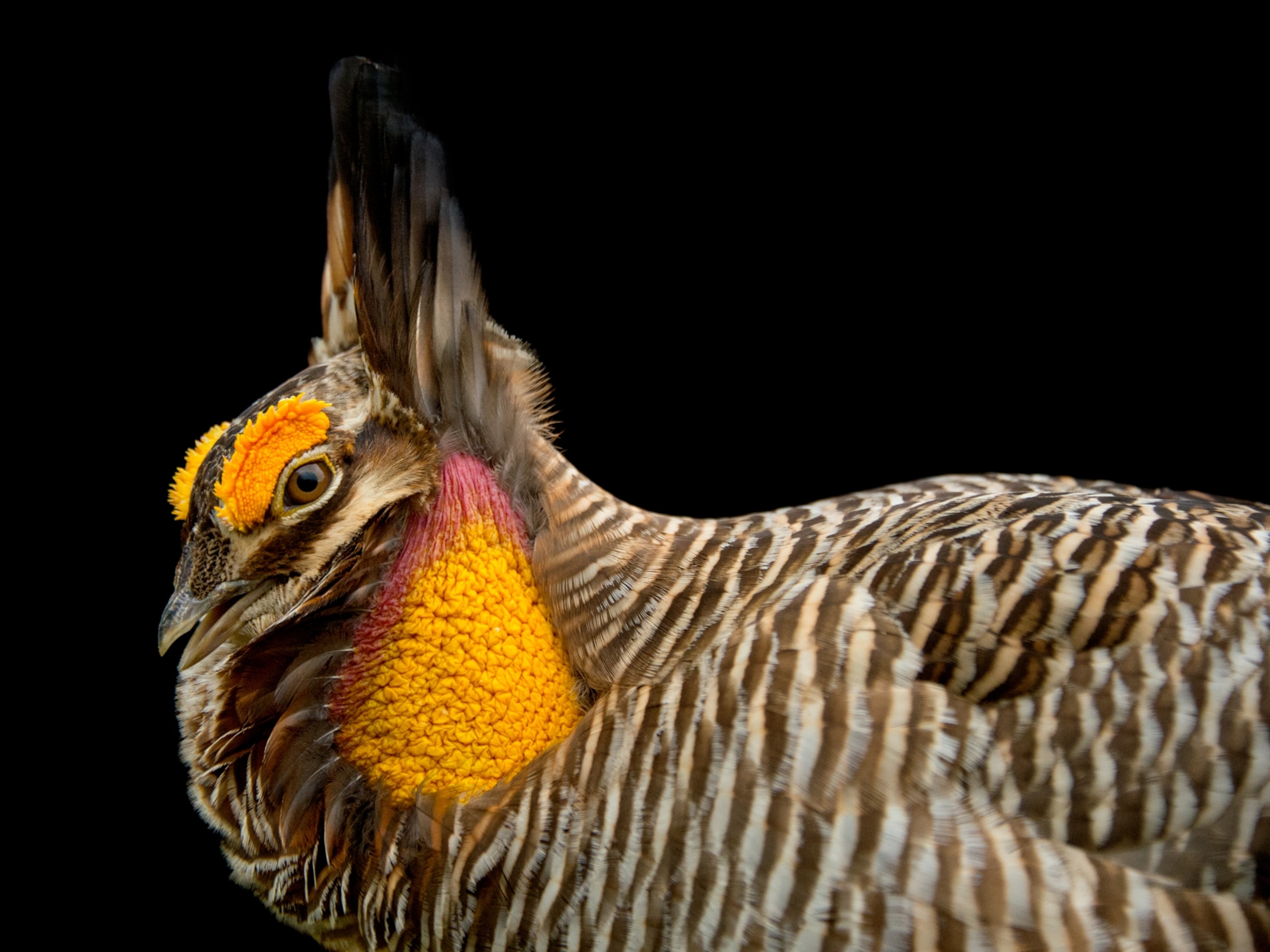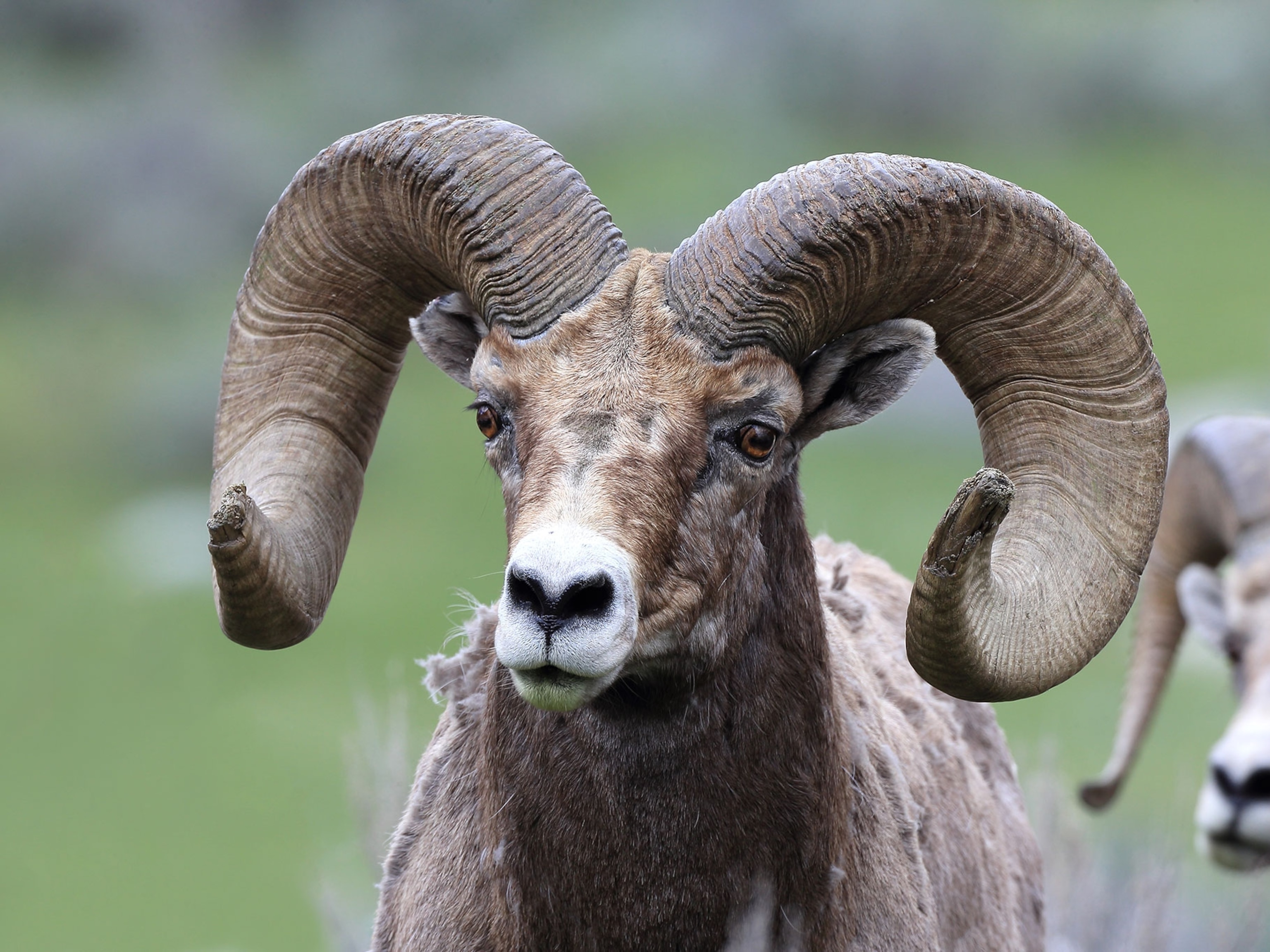
Disease-carrying mountain goats threaten ancient bighorn sheep herd
A unique herd of bighorn sheep has survived commercial hunting, human expansion, and isolation. Now it faces a new enemy.
Signs of bighorn sheep were scattered inches away from the cliff edge: Dirt packed down from where they slept, round droppings, and a still-pungent smell. The animals themselves were gone, melting away into distant layers of mountain and rock.
Steve Kilpatrick, a retired biologist now leading the Wyoming Wild Sheep Foundation, was in the mountains on the border of Grand Teton National Park in August surveying sheep as part of an annual effort to keep tabs on its dwindling population.
Fewer than 100 sheep now comprise the ancient Teton Range herd in northwest Wyoming—one of the most unique in the West. And biologists say it is on the brink of blinking out.
The threat list begins as a familiar mixture of habitat loss, overhunting at the turn of the 20th century, and broken migration routes. (Read more: Bighorn sheep teach other how to migrate.)
But the Teton Range herd faces something unusual even for wildlife in the modern world: meandering, invasive, disease-carrying mountain goats.
“If we stand by and do nothing, the goats will contribute to the demise of the herd,” says Kilpatrick, and they could disappear within a decade without intervention.
“It would be a shame to lose this iconic species in an iconic setting, i.e., a national park,” he says. “It reflects how we can or can’t coexist with wildlife in the bigger picture.”
Hiding from the World
Bighorn sheep once thrived across western North America until western expansion brought commercial hunting, land-use changes, and disease. What was once a species that numbered at least 1.5 million now has about 85,000 scattered in isolated populations from the middle of Canada to Mexico’s Baja California.
The Teton Range herd, which is technically two smaller herds lumped together, stopped migrating to stay away from human encroachment by isolating itself high in the craggy, snowcapped mountains that rim the southwestern edge of Yellowstone National Park.

Even for bighorn sheep, an animal that survives in some of the harshest terrain in the West, the Teton Range herd is tough.
They live year-round between 8,500 and 11,000 feet, where winter temperatures can reach as low as 40° below zero Fahrenheit and winds gusts blast as high as 100 miles per hour. For food, they scrape orange and brown lichen off of rocks and nip the dried tops of long-dead wildflowers and grasses. They move as little as possible, perching on cliff edges, ready leap to safety at the sign of a predator.
They have persevered on their own for tens of thousands of years.
Their isolation has an advantage: While outbreaks of deadly pneumonia, often transmitted from domestic sheep, wiped out tens of thousands of bighorns across the West, the Teton Range herd stayed healthy.
“The Teton herd that remained after the majority of bighorn sheep herds were wiped out are really valuable for the species in general,” says Alyson Courtemanch, a wildlife biologist for the Wyoming Game and Fish Department. “They are a reservoir of genes that were never lost.”
But scientists like Courtemanch are raising alarms, saying the sheep face a new round of threats that they can’t escape on their own. The first is an influx of backcountry skiers seeking deeper snow and bigger runs, scaring sheep and wasting the herd’s precious winter calories.
The second is pneumonia-carrying mountain goats.
The equally-charismatic animals, with their wooly beards and rock-hopping ways, were introduced into Idaho in the late 1960s and early ‘70s by the state’s wildlife department, and they’ve been moving northeast into the Tetons. Some models show the Tetons could support as many as 400 of them if left unchecked, Kilpatrick says. That means not only competition for food but also a potential pathway for disease. As mountain goats pass through herds of domestic sheep, they unknowingly collect pneumonia pathogens and march them toward bighorn sheep herds where the bacteria could be transmitted by friendly nose touches, coughing, or sneezing.
Some of the goats moving into the Tetons have already been tested and found to carry at least two of the five-known lethal pneumonia pathogens.
Controlling Goats and Herding Sheep
If the Teton Range herd could be gone in as little as a decade without intervention, as Kilpatrick and Courtemanch predicated, what can be done?
Controlling goat populations is one place to start, Courtemanch says.
But mountain goats aren’t like quagga mussels or cheatgrass, two other invasive and destructive species spreading across the country that are easy to hate. Goats are charismatic, gregarious, and popular among visitors.

It makes controlling where they can and can’t be tricky, she says.
Grand Teton National Park, where the bulk of the Teton Range herd lives, has been working on a plan to manage the goats, says Sarah Dewey, wildlife biologist for the park. The National Park Service recognizes the threat they pose, and she says they could have a solution as soon later this year. Wildlife managers are also working with backcountry skiers to help them avoid disturbing the wintering herd.
The herd’s unique genetics and high risk of introducing disease makes it an unlikely candidate for sheep translocations, which have repopulated many other herds in the West. (Read: In California, bighorn sheep are helicoptering their way back from the brink.)
In his wildest ideas, Kilpatrick has thought about trying to reintroduce migration routes to the herd. It would require someone to live in the mountains and essentially lure the Teton sheep into lower country with better food for the winter. It’s part fantasy, part real possibility, he says, but it also carries its own risks, such as disease exposure.
For now, biologists will continue surveying the mountains, looking for pungent beds and the creatures themselves to monitor the sheep and goat populations.
It’s a herd that has persisted for tens of thousands of years, Courtemanch says. Now, it’s up to humans to keep it alive.
You May Also Like
Go Further
Animals
- How can we protect grizzlies from their biggest threat—trains?How can we protect grizzlies from their biggest threat—trains?
- This ‘saber-toothed’ salmon wasn’t quite what we thoughtThis ‘saber-toothed’ salmon wasn’t quite what we thought
- Why this rhino-zebra friendship makes perfect senseWhy this rhino-zebra friendship makes perfect sense
- When did bioluminescence evolve? It’s older than we thought.When did bioluminescence evolve? It’s older than we thought.
- Soy, skim … spider. Are any of these technically milk?Soy, skim … spider. Are any of these technically milk?
Environment
- Are the Great Lakes the key to solving America’s emissions conundrum?Are the Great Lakes the key to solving America’s emissions conundrum?
- The world’s historic sites face climate change. Can Petra lead the way?The world’s historic sites face climate change. Can Petra lead the way?
- This pristine piece of the Amazon shows nature’s resilienceThis pristine piece of the Amazon shows nature’s resilience
- Listen to 30 years of climate change transformed into haunting musicListen to 30 years of climate change transformed into haunting music
History & Culture
- Meet the original members of the tortured poets departmentMeet the original members of the tortured poets department
- Séances at the White House? Why these first ladies turned to the occultSéances at the White House? Why these first ladies turned to the occult
- Gambling is everywhere now. When is that a problem?Gambling is everywhere now. When is that a problem?
- Beauty is pain—at least it was in 17th-century SpainBeauty is pain—at least it was in 17th-century Spain
Science
- Here's how astronomers found one of the rarest phenomenons in spaceHere's how astronomers found one of the rarest phenomenons in space
- Not an extrovert or introvert? There’s a word for that.Not an extrovert or introvert? There’s a word for that.
- NASA has a plan to clean up space junk—but is going green enough?NASA has a plan to clean up space junk—but is going green enough?
- Soy, skim … spider. Are any of these technically milk?Soy, skim … spider. Are any of these technically milk?
Travel
- Could Mexico's Chepe Express be the ultimate slow rail adventure?Could Mexico's Chepe Express be the ultimate slow rail adventure?
- What it's like to hike the Camino del Mayab in MexicoWhat it's like to hike the Camino del Mayab in Mexico




